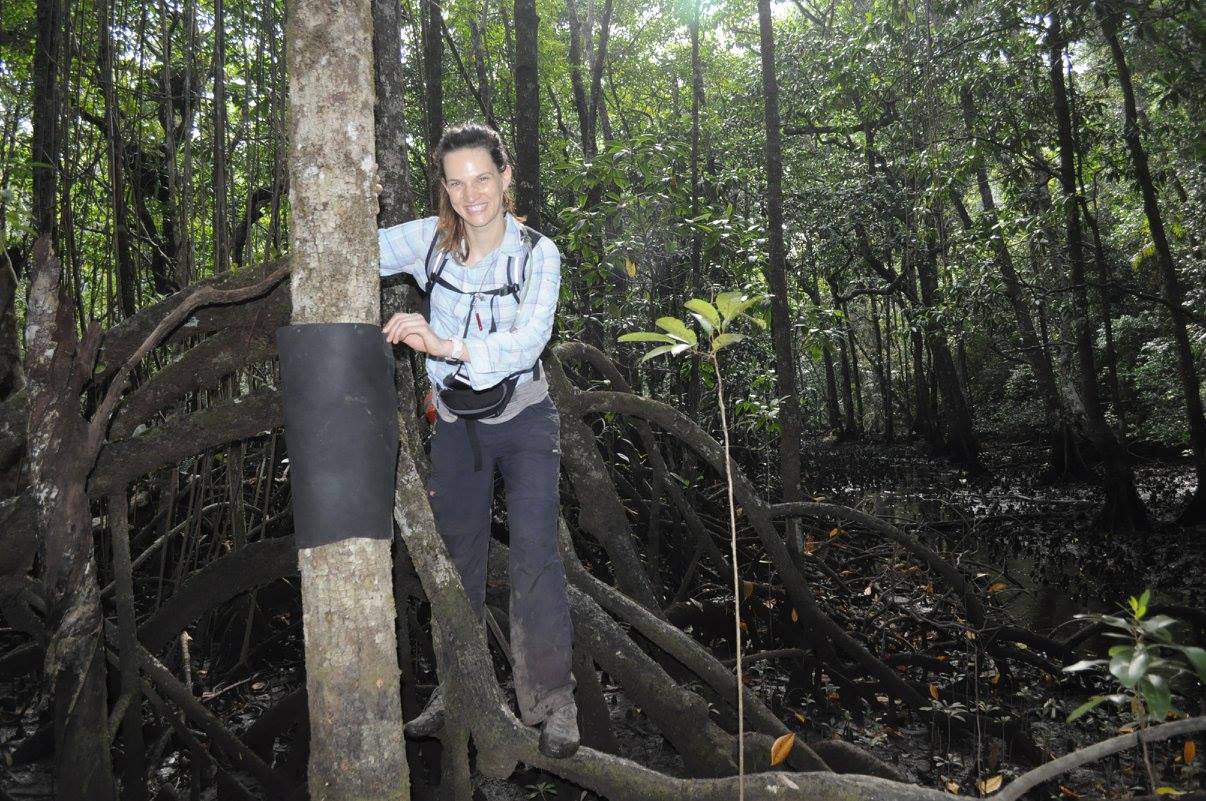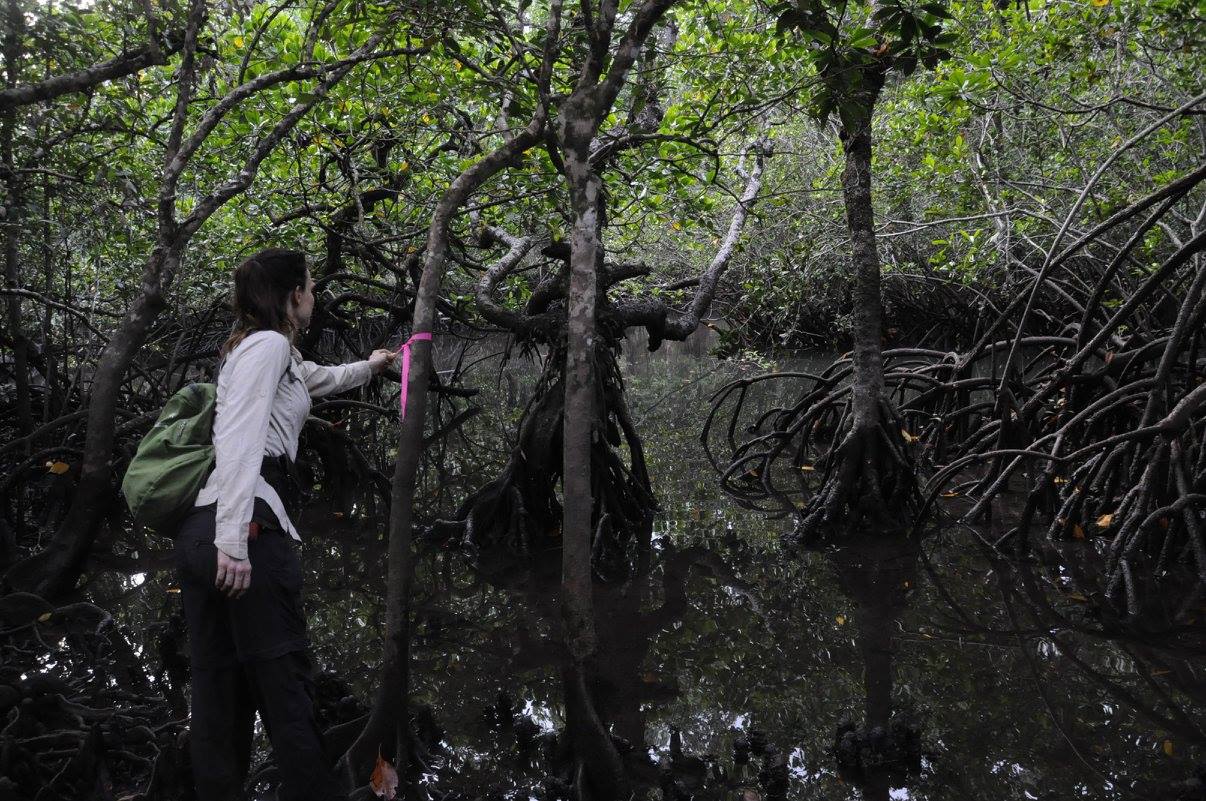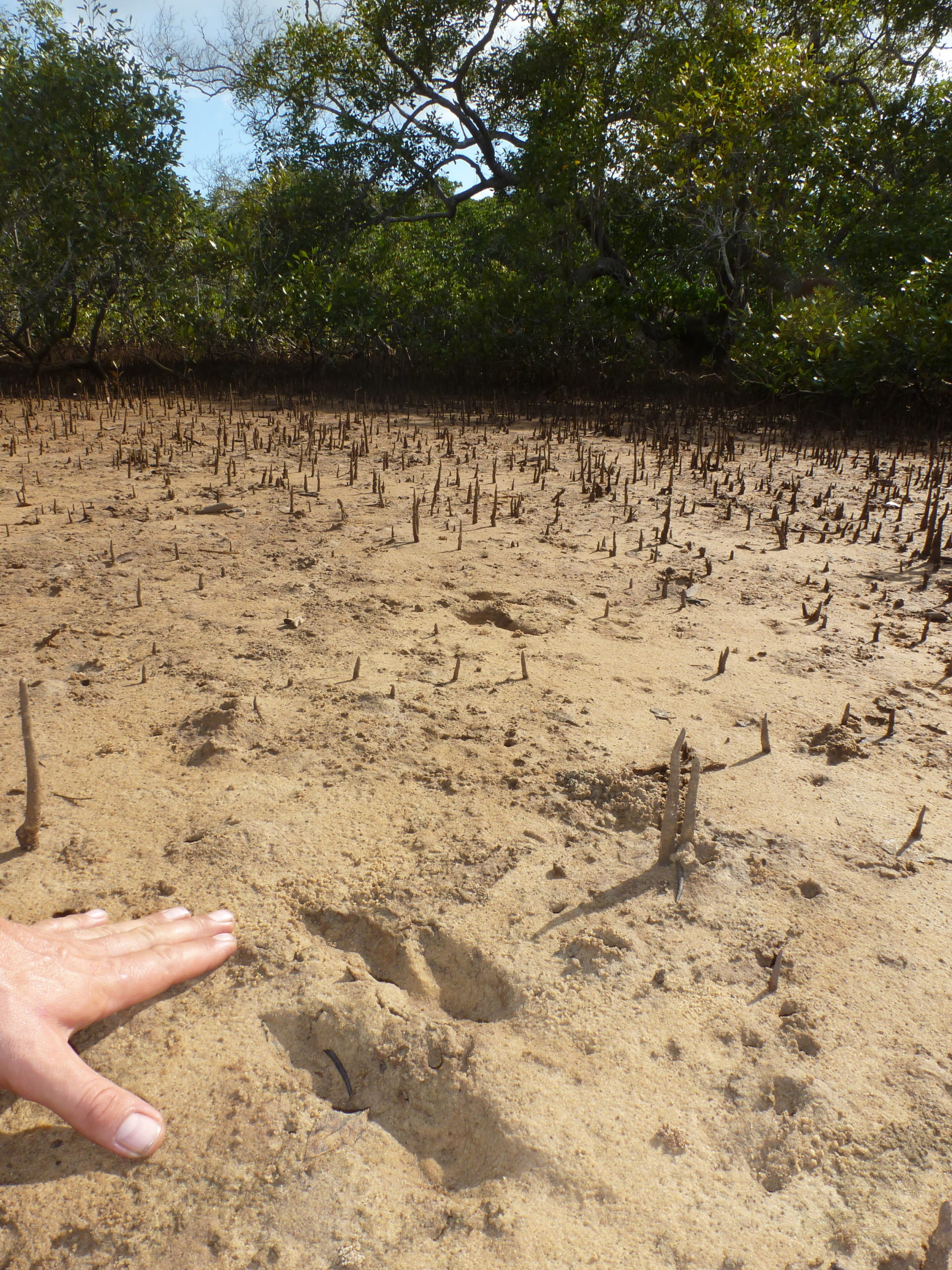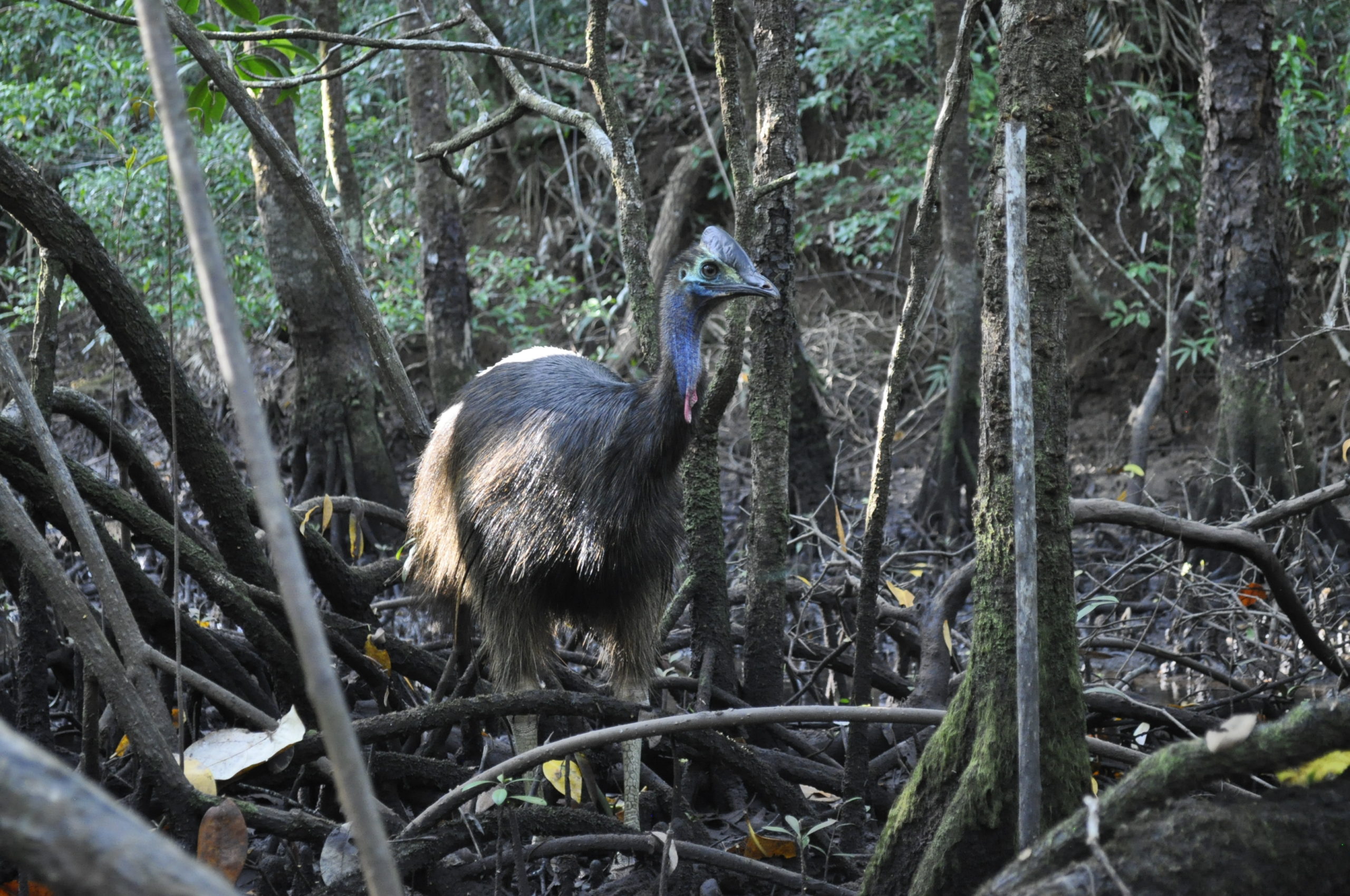Undervalued Animals of Mangrove Forests
An Interview with Dr. Stefanie Rog
There are many benefits of mangroves, and much of the time spent talking about them revolve around their benefits as carbon capture super-plants and providers of resources to communities. However, there is another major component to mangroves’ incredible nature that is less often mentioned – their amazing biodiversity.
Stefanie Rog, PhD is a Technical Officer at Wetlands International and an expert in mangrove wildlife. She agreed to an interview with the Global Mangrove Alliance to talk about her research, her experiences, and the importance of shining a light on mangrove wildlife.
Thank you for agreeing to this interview, Stefanie! Could you please introduce yourself and your background?

Photo courtesy of Stefanie Rog, 2016
Wetlands International is based in The Netherlands, a country that mangroves sadly don’t grow in! What drew you to study the wildlife of mangrove ecosystems?
Haha yes, maybe in the far future mangroves will migrate north to The Netherlands. Mangroves have intrigued me from a young age; I remember travelling to Indonesia with my parents when I was ten, and I was in awe by the beauty of hundreds of mudskippers between their roots. Since then, I have visited mangroves in over 15 countries, and I hope to visit many more in the future; the Sundarbans is still on my list. I find these ecosystems fascinating as they blur the boundary between land and sea; what could live in this mysterious habitat and why?
I read in your recent publications that most conservation efforts around mangroves center on the trees themselves or around shellfish and other seafoods instead of more typically “lovable” mammals, reptiles, or amphibians. Out of all the animals you’ve come across in your research, is there one that you feel is most underappreciated or under-represented? Is there an animal you have been surprised to find?
There is indeed a tendency to focus on the services the mangrove trees provide, like coastal defence, and the soil that benefits the climate by locking in high amounts of carbon. At the same time, the value of mangroves for biodiversity conservation, as well as the services that animals provide to mangrove forest health, is often overlooked.
While there is increased acknowledgement of large mammal species such as the tiger and the manatee occurring in mangrove habitat, the smaller vertebrate groups, such as bats and herpetofauna (reptiles and amphibians), are still underappreciated in mangrove conservation. Pollinating of mangrove flowers by bats is one example of the intricate relations between mangroves and their fauna. Still, we know little about the functional role species play in these systems. Nonetheless, in conservation efforts, it is important to consider these potential roles, as they could be crucial for a healthy functioning ecosystem. Animals I was surprised to find? I was extremely excited to see a tree kangaroo in the Daintree mangroves, and I detected tree frogs – animals you usually don’t associate with a saltwater environment. These forests never cease to amaze!

Photo courtesy of Stefanie Rog
As a scientist, I’m sure you have many areas of interest that you’d like to pursue, but is there one topic or animal that you’re most excited to study?
I would be especially interested in studying the interconnections between terrestrial and marine realms created by faunal movements. For example, a fundamental gap in our knowledge of mangrove ecology relates to the services that terrestrial fauna provides and receives from this ecosystem. As mangrove ecosystems continue to be degraded, it will be essential to understand how this degradation impacts the services mangroves provide to terrestrial vertebrates. Habitat loss could increase the importance of mangrove systems in connecting fragmented terrestrial habitat due to the linear nature of these ecosystems. Moreover, populations of populations of felids and primates been reported to use mangroves as a last refuge when their primary forest habitat was lost. It will be essential to understand the extent to which ecosystems can provide all the resources a species requires, particularly if the provisioning role as a habitat refuge of mangroves becomes critical for more species.
Read more about Dr. Rog’s work with terrestrial vertebrates in mangrove ecosystems here.

Tracks, likely from a kangaroo | Photo courtesy of Stefanie Rog
Are there any recent tools or advancements, like the recent Global Mangrove Watch release, that you have found to be particularly beneficial to studying wildlife in coastal ecosystems?
The Global Mangrove Watch is a game-changer in mangrove conservation. I am excited to follow the developments where mapping layers can start to provide real-time and small scale information to inform local management on forest extent. I do, however, also believe that there will always be value to on-ground field data to verify the quality of the forest. While there is the possibility to measure indirect indicators such as habitat connectivity to predict what species could occur in a mangrove forest – local knowledge on the occurrence of (threatened and invasive) species will remain vital for effective management. A rapid field design which I developed and tested provides managers with a tool to rapidly collect such knowledge. Field knowledge, in combination with the highly developed mapping technologies, is I believe the best combination to work towards effective mangrove management.
What is the most important issue for you for the future of wetlands? Anything that you are hopeful or excited about for the future?
At this time of climate and biodiversity crisis, the issues can feel overwhelming, and I think there is no one sole factor responsible for wetland decline. However, I do get hope from the cumulative power of small initiatives that together can form a big wave of positive change. Wetlands are the planet’s greatest natural carbon stores, rich in nature and vital to human life. They act as water sources and purifiers. They protect our shores. They are crucial to agriculture and fisheries. Reviving wetlands is I believe one of the most effective ways we can heal the climate and help biodiversity.
Is there anything else you feel more people should know about regarding wildlife and mangroves?
That if you take the time to look, mangrove wildlife diversity goes so much further than just mosquitos, herons and crabs! I hope that this interview has inspired people to explore these rainforests of the sea.
Do you have a favorite mangrove animal? Has that changed over time as you continue to study these ecosystems?
This has to be the most difficult question! Over time I have learned that animals you least expect also venture into mangroves, which makes it exciting to think about what is still left to discover about these ecosystems. For example, in the Daintree in tropical Australia, I was startled by various Cassowaries carefully stepping through mangroves at low tide; what were they doing? Were they using the mangroves as a faster route to get to the adjacent rainforest? It would be interesting to investigate their relationship with mangroves further. I also have to mention mudskippers as these prehistoric-looking animals are so well adapted to live on both land and sea, like mangrove trees themselves!

Cassowary in Australian Mangroves | Photo courtesy of Stefanie Rog
In your most recent paper, an assessment protocol details how animals were surveyed in mangroves in day and nighttime, I imagine there may have been some challenges during that as mangroves aren’t the easiest forests to move through! Do you have a favorite animal-related story from doing coastal wetlands research?
Fieldwork in mangroves is indeed challenging. You have to be aware of the tide coming in, the hidden mud crab holes which can snap your ankle, and in some regions even large predators! Imagine having spent four days of fruitless fieldwork, sleeping in blocks of 4 hours to conduct both night and day surveys, and encountering no animals whatsoever. My research assistant, Ernest Minnema, and I were wading knee-deep through mangroves on Stradbroke Island, Queensland Australia, already walking for a couple of hours, solely energized by dextrose energy tablets. Suddenly we heard loud splashing coming closer; quite scary as it sounded pretty big and we had nowhere to run! We slowly started to see the outline of a dark brown animal, a dog from the village a couple of kilometers away maybe? With a big sigh of relief, we finally realized that it was a swamp wallaby, jumping in concentration through the deep water avoiding the mangrove roots. It was a fantastic reward after the exhausting days, and my emotions got the upper hand. The wallaby jumped closer, looked at us and probably thought the same as us, “wow, you never know what you will encounter in the mangrove forest”!
Thanks again to Dr. Stefanie Rog for answering our questions!